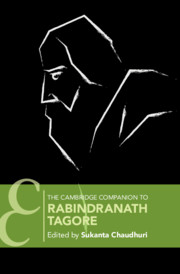Book contents
- Frontmatter
- Contents
- List of Illustrations
- Notes on Contributors
- Preface
- Note on Conventions and Practices
- 1 Rabindranath Tagore: From Art to Life
- 2 A Garland of Many Tagores
- Part I Overviews
- 3 Rabindranath and His Times
- 4 Tagore's Poetry: An Overview
- 5 ‘Something of a Musician’: Tagore's Songs
- 6 Rabindranath Tagore: Drama and Performance
- 7 Imagined Worlds: The Prose Fiction of Rabindranath Tagore
- 8 The English Writings: An Overview
- 9 Tagore and Indian Literature: Influence and Presence
- 10 Rabindranath Tagore and Literary Communication across Borders
- 11 Tagore and the Visual Arts
- Part II Studies
- List of Tagore's Works Cited, with Index
- Further Reading
- General Index
6 - Rabindranath Tagore: Drama and Performance
from Part I - Overviews
Published online by Cambridge University Press: 24 December 2019
- Frontmatter
- Contents
- List of Illustrations
- Notes on Contributors
- Preface
- Note on Conventions and Practices
- 1 Rabindranath Tagore: From Art to Life
- 2 A Garland of Many Tagores
- Part I Overviews
- 3 Rabindranath and His Times
- 4 Tagore's Poetry: An Overview
- 5 ‘Something of a Musician’: Tagore's Songs
- 6 Rabindranath Tagore: Drama and Performance
- 7 Imagined Worlds: The Prose Fiction of Rabindranath Tagore
- 8 The English Writings: An Overview
- 9 Tagore and Indian Literature: Influence and Presence
- 10 Rabindranath Tagore and Literary Communication across Borders
- 11 Tagore and the Visual Arts
- Part II Studies
- List of Tagore's Works Cited, with Index
- Further Reading
- General Index
Summary
The overwhelmingly lopsided critical attention given to Tagore's poetry and fiction, and to a lesser extent his essays, paintings, philosophical discourses, and educational experiments, has submerged assessment of his equally outstanding achievements in the performing arts, specifically theatre and dance. And despite the fulfilment of his own prophecy about his songs outliving all his other creations in popularity, hardly any booklength scholarly analysis of his extraordinary output in music has appeared in English. The present chapter limits its scope to Tagore's plays, but that automatically embraces his work in dance as well, since his choreographic contributions formed an integral part of their productions.
I should also emphasize at the outset that Tagore did not just write his plays; he acted in and directed them, composed all their songs and music, and designed and choreographed many of them. To read them only as texts consciously blindsides oneself from all these activities. He reiterated the primacy of their performatory dimensions time and again. About his very first drama, Bālmiki-pratibhā (The Emergence of Vālmiki's Genius, 1881), he stressed that it ‘is not a composition which will bear being read. Its significance is lost if it is not heard sung and seen acted.’ Towards the end of his career, he introduced his dance drama Chandālik (The Chandāl's Daughter, 1938) with virtually identical words: ‘It needs to be kept in mind that this play is to be seen and heard, but not read.’ By analogy, we can quote from his similar comments about songs. In his autobiography he observed, ‘I am always reluctant to publish books of the words of songs, for therein the soul must needs be lacking.’ In a characteristically poetic simile, he wrote about Bāul songs, ‘the best part of a song is missed when the tune is absent; for thereby its movement and its colour are lost, and it becomes like a butterfly whose wings have been plucked.’ It has become the norm in drama criticism to explicate play texts with a constant eye on their onstage visualization, leaving behind the old method of treating them exclusively as literature, like poetry and fiction. There can be no better exemplar of this than Tagore's huge dramatic corpus, of over seventy scripts and libretti.
- Type
- Chapter
- Information
- The Cambridge Companion to Rabindranath Tagore , pp. 102 - 130Publisher: Cambridge University PressPrint publication year: 2020



